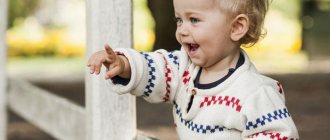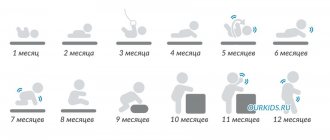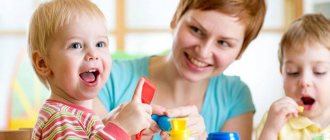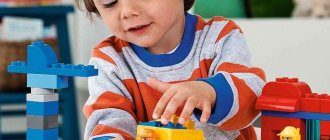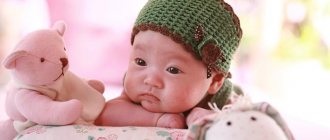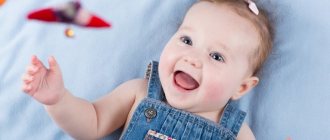Child development: first month
- The first thing that usually surprises inexperienced parents is the baby’s big head. This is fine.
- In the first month of life, the baby’s arms and legs are bent and his fists are clenched. Doctors call this condition flexor position.
- The body of a newborn is usually covered with vellus hairs - lanugo. Over time, they will disappear on their own - “fall out”.
- The baby's fingernails and toenails reach the edge of the finger, and sometimes longer.
- The eyebrows and eyelashes of most newborns are poorly developed, and white dots - the so-called milia - are clearly visible on the face.
- The eye color of all newborns is blue-gray.
- Newborns breathe frequently - up to 60 breaths per minute, heart rate - 140-160 beats per minute.
Age norms by month
Average indicators of speech development are important for determining normality or pathology. They can shift depending on the individual characteristics of the baby and the conditions of his growth. It is known, for example, that every serious illness suffered by a young child “throws him back” a little in terms of the development of skills and abilities.
- The first month and a half of life. Sounds appear with which the child reacts to the speech of the mother and other close people addressed to him. These are mainly vowel sounds and their combinations (o, a, u, ya, ay, ua). The child is able to focus his gaze on the faces of his relatives, on the toys shown to him, and listen to the sounds of human speech. During this period, children with prerequisites for a future speech disorder can be identified by assessing the nature of their cry - shrill or very quiet; sobs or screams are possible while inhaling, and not while exhaling, as is expected during normal development.
- At 2–3 months, the “revival complex”, consisting of characteristic movements of the arms and legs at the sight of the mother, is accompanied by guttural sounds and their combinations with vowels (a-a-a, a-a-gi, a-a-gu, a- ha). Such hooting occurs not only when in contact with familiar close people. It can occur spontaneously when the baby is full and happy, or when looking at a toy. Another achievement of this stage is auditory and visual concentration on the source of sound or movement.
- At 3–5 months, the child seeks contact with adults with his gaze, smile, and utters drawn-out sounds - humming. They most often consist of sound combinations such as gee, khy, agu, aga, ga, ege, aa. Sometimes these combinations are so bizarre that they are difficult to reproduce. The pathology at this stage is considered to be monotonous humming sounds accompanied by chaotic movements of the arms and legs, and a lack of intonation expressiveness.
- At the 6th month of life, babbling appears in the child’s speech, consisting of such combinations of sounds as “ga, ka, pa, ma.” Constantly repeating themselves, they already become quite similar to models of words, as if pronounced syllable by syllable: “ma-ma-ma-ma, ba-ba-ba.” Such improvisations appear only in a good mood, and for now they cannot be a means of communication. During this period, congenital deafness can be diagnosed, because a deaf child has no babbling, and the sounds of humming gradually fade away.
- At the 7th month of life, a connection appears between an object and the word denoting it. If parents specifically pay attention to this skill, show objects and toys, naming them several times, then the child will quickly learn to look for them at the request of an adult. Words must be clearly distinguishable by sound. In a child with delayed speech development, babbling is absent or manifests itself in separate elements, the baby does not imitate the movements of an adult, and does not follow the simplest verbal commands.
- By the end of the first year of life, on average, a child’s active vocabulary contains from 10 to 25 words. Along with correctly pronounced words (dad, baba, uncle, lalya), these can also be babbling words (am, bobo, bang), and partially pronounced forms of words (“kach” - swing, “zya” - impossible), as well as onomatopoeia with animal voices and surrounding sounds (meow, ha-ha, beep). By this time, the connection between the word and the object it denotes should be established. By the end of the first year of life, speech is ideally a means of communication between a child and adults.
You should be wary if the baby prefers to express his desires with gestures, facial expressions and mooing instead of words. By the end of the first year of life, such manifestations are not considered a deviation from the norm if, in addition to them, words are also used in communication.
Sense organs of a newborn
A newborn baby can distinguish tastes well - the baby calms down from sweets and makes swallowing movements. Bitter, salty and sour tastes can cause anxiety and crying in the baby.
A newborn's sense of smell is poorly developed , but babies often react to odors whose source is in close proximity (for example, a baby may not like the smell of breast cream).
the touch of his body quite well and reacts even to slight skin irritation or cold hands.
A child's vision in the first month of life is poorly developed - the newborn perceives only light. The gaze is not fixed. Eye movements are uncoordinated, that is, the child has physiological strabismus.
The development of a child in the first month of life is also characterized by a low level of hearing. But the child reacts to strong sounds - he shudders, the facial muscles contract, the frequency and depth of breathing changes.
Feeding a newborn: how much should a baby eat at 1st, 2nd, 3rd or 4th weeks of life?
Luckily, you don't have to stick to a strict schedule here. Watch your baby and notice how he behaves when he is hungry. At this stage, the child signals that he is hungry using the search reflex (see description of reflexes), he may also smack or suck his fist. A crying baby can also show that he is hungry, but it is better to feed him earlier and not make him upset. On average, a baby needs at least eight feedings per day, both during the day and at night. Your baby may ask to be fed more often during growth spurts - and these occur differently for each baby, most often at the end of the second week and between the third and sixth weeks. When the baby is full, he looks lethargic or falls asleep. Breastfeeding mothers are often concerned about questions: “Is there enough milk?”, “Is the baby latching on and sucking correctly?” In such cases, it is recommended to consult a pediatrician or breastfeeding specialist. But all over the world they adhere to the rule of feeding at the baby’s request, unless there are medical indications for a different feeding regimen.
Should I give my child vitamins and supplements?
On the issue of introducing vitamins and supplements into a child’s diet, regardless of the method of feeding (breastfeeding, bottle-feeding, or a combination of breastfeeding and bottle-feeding), it is best to consult with a pediatrician. For example, children under one month old are prescribed vitamin D in certain dosages.
Counting wet diapers
Mothers constantly worry whether their baby is getting enough nutrition. To make sure of this, you can count how many times a day you change diapers and what they look like. Don't be alarmed if, in the first few days, you unwrap the diaper and see a thick, dark green or black substance. Your baby's first stool consists mainly of meconium. After meconium passes from the body, the stool becomes softer and acquires a yellow-green color. Normally, during the day you will have to change six wet diapers and three or four diapers with stool, but, of course, all children are individual.
You can also tell that the baby is getting enough nutrition by the way he swallows (there should be a distinct swallowing sound). If the baby behaves calmly for several hours after feeding, it means he is full. Based on the results of measurements at an appointment with a pediatrician, you can also understand whether the child receives enough nutrients for growth. In addition, if the child is getting heavier, there are more and more folds on the limbs (constrictions), and the newborn’s wardrobe is changing quickly, then obviously the baby is doing well with the additions.
Changing diapers will be difficult at first, but you'll get the hang of it quickly!
Child development – 1 month
The development of a child at 1 month gives parents many joyful moments:
- at 1 month, the baby, lying on his stomach, holds his head for several minutes;
- the child smiles, in moments of wakefulness he gurgles;
- if you show a child an object that is interesting to him, the baby will fix his gaze on it;
- the periods of time during which the child does not sleep gradually increase;
- The baby’s umbilical wound has already completely healed at one month;
- at one month, the baby most often cries due to hunger, and feeding on demand (if the baby is breastfed) is the best way to calm the baby;
- Crying is still the baby's primary way of communicating; at about 6 weeks, the baby reaches the peak of the so-called “cry curve.”
What a child should be able to do (child development from 1 to 12 months)
What can a 1 month old baby do?
From birth to 1 month, the baby sleeps a lot (almost 70% of the time) and eats often, his actions are reflexive, and his movements are chaotic. By the end of the first month, he usually fixes his gaze on an object, reacts to loud sounds, recognizes his mother's voice, begins to coo and tries to raise his head when lying on his stomach.
Read more
What can a 2 month old baby do?
The baby becomes more active and sleeps less. She can not only recognize her mother, but also guess her mood, follows the object with her gaze, tries to reach out to it, grab it. Movements become more meaningful. The child begins to smile.
Read more
What can a 3 month old baby do?
The child already confidently holds his head, straightens his legs, tries to rise on his elbows when lying on his stomach. Hand-eye coordination develops. The baby becomes more emotional - he laughs, imitates the facial expressions of his parents, cries, demanding attention. At this time, it is already possible to recognize the character of the little person.
Read more
What can a 4 month old baby do?
The baby confidently turns over from his back to his stomach, crawls, and tries to sit up. His favorite toys appear, he grabs them, examines them, tastes them. Distinguishes between friends and strangers, begins to respond to his name.
Read more
What can a 5 month old baby do?
Many children at this age are already sitting with support and trying to get to their feet. The child happily plays with objects - throws, knocks, licks, etc. Encourages parents to communicate, reaches out to mother, pronounces the first syllables. Usually at this time children begin to cut their teeth.
Read more
What can a 6 month old baby do?
Children at six months old sit up on their own and sit without support, try to get on all fours, and crawl on their bellies. The baby can drink from a held mug, picks up toys, rearranges them, and studies them. A child at this age is very emotional - his mood may change frequently.
Read more
What can a 7 month old baby do?
The “fidget period” begins - the child actively crawls, stands at the support, and walks by the hands. The baby improves grasping movements and develops fine motor skills. He begins to imitate adults, pronouncing simple words of two syllables. At this age, the child tastes everything.
Read more
What can a baby do at 8 months?
The baby gets up on his own and moves freely around the familiar space. He can bring or show something, waves his hand goodbye, closes the lids, strings the rings of the pyramid. Likes dancing. The first conscious words and a wide range of emotions appear.
What can a 9 month old baby do?
The child tries to eat with a spoon, remembers where the mother put the object, knows the words “give”, “put”, “come”, etc. Likes to repeat the actions of adults, tries to manipulate parents by screaming and crying.
What can a 10 month old baby do?
A child at this age already has well-developed fine motor skills, he performs more complex actions, is often interested in small objects, and moves them from place to place. Shows parts of the face, names animals, understands the word “no”.
What can a baby do at 11 months?
At this time, the baby likes to be independent (as much as possible) - he eats, drinks, dresses himself. He can speak sternly, loves praise, and communicates a lot in his “own” language.
What can a 12 month old baby do?
Actively participates in dressing, bathing, feeding. Begins to develop food cravings. Knows what to do with objects, understands everything that is told to him. He himself can express his desires. Despite his “adulthood”, he really needs his parents and is attached to his toys.
#PROMO_BLOCK#
You can also learn the basic rules of caring for a newborn in our blog.
Baby development at two months
At two months, the child’s skills that just began to appear in the first month of life are significantly stabilized and strengthened:
- at two months the child begins to hold his head upright, examines his surroundings with interest, turning his head in different directions;
- If you show your baby a bright toy at a distance of 20-30 cm, he will fix his gaze on it for quite a long time. If you move the toy slowly, the baby will follow it;
- If the child is not hungry and is not bothered by tummy pain or any other problems, he can walk for quite a long time and smile.
7-12 weeks
From one and a half to three months, muscle tone decreases. During this period, the baby masters the following skills:
- grabs nearby toys;
- rolls over from stomach to back and back;
- holds his head confidently;
- examines objects;
- walks, “communicates” with relatives and toys.
At 2 months, the baby is already very interested in what is happening around him
. By the end of 3 months of life, colic gradually disappears. About 70% of children during this period already behave calmly in the evenings, and their tummy bothers them less and less.
Fourth trimester
The first three months of life are also called the fourth trimester of pregnancy. During this period, the baby urgently needs the constant presence of his mother, tactile, visual and verbal contact. Therefore, you should not limit your presence nearby - you need to try to take him in your arms more often, show him more new things, and help the child adapt to this world. “Hand training” is impossible in the first three months - the baby now needs the constant proximity of his mother in order to grow and develop.
Digestion
Stool occurs 2-3 times a day, it has a pasty consistency and a distinct creamy milky smell. When bottle-fed, the smell is stronger, and the color can vary from mustard to green and brown. If the child behaves normally and is not bothered by this, then there is no need to worry. If mucus or blood streaks appear, you need to contact a pediatric gastroenterologist and take a coprogram to rule out enzyme deficiency.
Child development at four months
The development of a child in the fourth month is the appearance of a whole series of skills that are very pleasant for parents, and the gradual disappearance of natural, but rather unpleasant symptoms in the baby’s condition:
- at four months the child’s colic disappears, this is largely due to the maturation of the nervous system;
- at four months the child is already turning over from his back to his side, and sometimes onto his tummy;
- the baby learns to use his hands - having noticed something interesting in his reach, the baby tries to reach the object with his hands;
- in response to words addressed to the baby, the child’s smiling face clearly manifests a “revival complex” - the baby willingly laughs and is involved in emotional communication;
- at four months, the child unmistakably distinguishes his mother from other people.
Stages of newborn development
- home
- To our clients
- Articles for parents
- Child under 1 year
- Stages of newborn development
>
>
>
>
From birth to the 10th day of a child’s life.
- Keeps a moving object in his field of vision (step tracking) - from a position lying on his back, fixes with his gaze for 5-10 seconds a moving object located in his field of vision at a distance of 40-50 centimeters. Eye movements are spasmodic, sometimes accompanied by a turn of the head. General movements are inhibited.
- Startles and blinks at a sharp sound (auditory orientation reaction) - 2-3 clap are made to the right and left of the child, out of his field of vision.
From 10 to 20 days of a child’s life.
- Holds a stationary object in his field of vision - fixes with his gaze for 5-10 seconds a stationary object located in his field of vision at a distance of 40-50 centimeters. General movements are inhibited.
- Calms down with strong sound (auditory concentration reaction) for 10-15 seconds.
1 month of a child's life.
- Follows - smoothly follows a bright object located in its field of vision at a distance of 40-50 centimeters.
- Listens to the voice of an adult, the sound of a toy (long-term auditory concentration)
- The first smile in response to addressed speech.
- While lying on his stomach, he raises and holds his head for 5-20 seconds.
- Makes individual sounds in response to conversation, sometimes the reaction is delayed by several seconds.
2 months of a child's life.
- Looks for a long time at a stationary object that attracts attention and follows a moving object for a long time (long-term visual concentration).
- Turning the head towards the sound stimulus, “searching” movements of the head and eyes during a prolonged sound (search reaction).
- Smiles, turns his head, holds his gaze on another child for 15-30 seconds (prolonged visual concentration on another child).
- Spontaneously pronounces individual sounds.
3 months of a child's life.
- Visual concentration in a vertical position - a child, from a position in the arms of an adult, watches for 30-40 seconds a stationary or moving object or the face of an adult talking to him.
- A complex of “revival” appears in response to speech addressed to it, actively looking with its eyes for the source of the sound (another child making sounds)
- Accidentally bumping into toys located at a distance of 10-15 centimeters above his chest, he perks up, bumps into them again, tries to grab the toy and follows the movements of his hand with his eyes.
- Lying on his stomach, he rests on his forearms and raises his head for up to 2-2.5 minutes. With support, he leans for 45-60 seconds on solid support with his legs bent at the hip joints, resting on the entire foot. In the hands of an adult, he holds his head upright position up to 1-1.5 minutes.
4 months of a child's life.
- Recognizes the mother, rejoices - looks at the mother expectantly, as soon as she speaks - smiles joyfully, gurgles, reaches out to the mother. When the mother leaves, she expresses dissatisfaction.
- Turns his head towards an invisible sound source, finds it with his eyes and watches it for 5-10 seconds.
- During wakefulness, a “revival complex” often and easily arises, laughs loudly in response to speech, and reaches out to another child.
- Examines, grabs and feels toys that attract attention.
- Gulit.
- During feeding, grasps and holds the mother's breast or bottle with her hands.
5 months of a child's life.
- Distinguishes close people from strangers (reacts differently to faces) - when seeing the face of a loved one, a “revival complex” arises, when seeing a stranger, movements are slowed down, wariness appears, the child frowns and may cry.
- Recognizes the voice of the mother and loved one. Distinguishes between strict and affectionate intonation of speech. Reacts to it in a differentiated manner.
- He rejoices at another child, takes a toy from his hands, and gurgles.
- Clearly takes toys from the hands of an adult, often takes toys with one hand, holds them in his hand for 1-2 minutes.
- Lies on his stomach for a long time, raising his body and leaning on the palms of his straightened arms. He turns over from his back to his stomach. Stands evenly and steadily with support for 3-4 minutes.
- It hums melodiously for a long time
- Eats thick food from a spoon, opens his mouth and removes food with his lips, eats slowly.
6 months of a child's life.
- Recognizes his own name (rejoices, turns towards the adult), distinguishes between his own and someone else's name.
- Freely takes toys from different positions, plays, transfers toys from hand to hand.
- Rolls over from back to stomach. Moves slowly, moving his hands or crawling a little, trying to get a toy.
- Begins to babble (says individual syllables, often once), listens to an adult and tries to repeat the syllables.
- He eats well from a spoon and drinks liquid food from a cup.
7 months of a child's life.
- Actively manipulates toys.
- Crawls well and a lot in different directions
- To the question “Where?” finds a familiar object with his gaze (repeatedly named and constantly located in one place)
- He babbles for a long time, repeating the same syllables.
8 months of a child's life.
- Observes the actions of another child, laughs, babbles.
- Imitates the actions of adults (rolls a ball, opens a lid, etc.)
- He sits down, sits, lies down. He gets up, holding the barrier with his hands, stands and lowers himself. He steps over, holding the barrier.
- Performs previously learned actions - without showing, performs “okay”, “give me a pen”.
- Pronounces various syllables loudly, clearly, and repeatedly.
- He holds and eats bread.
9 months of a child's life.
- He acts a lot by imitation and uses objects differently.
- Moves from object to object, holding onto them with his hands (objects should be at a distance of about 35 centimeters from each other).
- Knows his name and turns around when called. To the question “Where?” finds familiar objects in different places with his gaze, regardless of their permanent location.
- Imitating an adult, he repeats well-known syllables after him.
- Drinks from a cup, holding it with his hands.
- Neatness skills are being developed (they are calm about the planting process).
10 months of a child's life.
- Performs learned actions independently or at the request of an adult.
- With the help of an adult or holding the railing, enters sideways onto a low slide and descends from it at a side step
- On the command “give” he finds and gives familiar objects.
- Imitating an adult, he repeats after him syllables previously unknown to him.
11 months of a child's life.
- Rejoices at the appearance of other children and reacts selectively to them.
- Masters new actions, performs them according to orders and imitation (puts cube on cube, removes and puts rings with large holes on the rod). Performs previously learned actions according to verbal instructions (without demonstration).
- Stands independently, takes the first independent steps.
- The first generalizations appear in understandable speech (brings 2-3 toys of the same name - ball, car, doll)
- Pronounces the first designation words (light words) - “kis-kis”, “av-av”, “give”.
12 months of a child's life
- Distinguishes objects by shape (cubes, bricks, etc.), recognizes photographs of a familiar person (mom, dad).
- Plays with other children, looking for a hidden toy.
- Walks independently, without support, in alternating steps.
- Understands the word “impossible” and stops the prohibited action.
- Easily imitates new syllables, pronounces 6-10 simplified words.
- He drinks from a cup himself, takes the dishes with his hands and places them on the table.
1 year 3 months of the child's life.
- Increases the stock of understandable words, carries out at least 3 instructions from an adult.
- Actively uses babble and lightweight words.
- Focuses on the size of objects (more or less, with a difference exceeding 3 centimeters).
- Independently reproduces previously learned actions during the game.
- Walks for a long time without sitting down, changes position (squats, bends, turns, backs away).
- Eats thick foods independently with a spoon.
1 year 6 months of a child's life.
- Generalizes objects according to essential characteristics in understood speech (finds objects that are homogeneous in terms of characteristics)
- The correct analogues of lightweight words appear (car - instead of “bi-bi”, etc.).
- Focuses on 3-4 contrasting shapes of objects.
- Steps over low obstacles with an extended step.
- Eats liquid food independently with a spoon (holding the handle from above in the fist).
1 year 9 months of the child's life.
- Understands a simple story from an adult based on a picture and answers questions.
- Uses words and two-word sentences.
- Focuses on 3-4 contrasting sizes of objects with a difference of 3 centimeters.
- Walks on a limited surface raised not high above the floor without the help of an adult.
- Partially undresses with the help of an adult.
- Reproduces simple plot buildings - “gate”, “bench”, “house” from bricks, cubes.
2 years of a child's life.
- Understands a short story by an adult without showing pictures about events that happened in the child’s experience and answers questions.
- Uses three-word sentences, adjectives and pronouns.
- Steps over low obstacles in alternating steps.
- Focuses on 3-4 contrasting colors.
- Performs a sequential series of several actions, using objects for their intended purpose (the beginning of the story game).
- Partially puts on clothes with the help of an adult.
2 years 6 months of a child's life.
- Uses multi-word sentences containing more than three words. Questions arise: “Where?” and where?".
- Selects basic geometric shapes (cube, ball, brick, prism, cylinder, cone) and objects of four primary colors based on the model.
- The game is story-based. The child independently makes simple plot buildings and names them.
- Fully dressed. Doesn't know how to button buttons or tie shoelaces.
- Steps over an obstacle 20-30 centimeters high.
3 years of a child's life.
- Begins to use complex subordinate clauses. Questions appear: “Why?”, “When?”, “What?”
- Correctly uses various forms of objects (puts together a mosaic).
- Elements of role-playing game appear, names your role to the question “Who are you?” Complex plot buildings appear, including many elements.
- Draws, sculpts simple objects and names them.
- Fully dressed. Can button buttons and tie shoelaces with a little help from an adult.
- Uses the napkin as needed, without being reminded.
- Steps over an obstacle 30-35 centimeters high.
Baby development at six months
At six months, the child freely rolls over from his back to his stomach and back, turning on his side and trying to sit up. When lying on his stomach, the baby rests on his outstretched arms. He easily recognizes close people, not only family members, but also friends. At about six months, a rather difficult period in a baby’s life begins – teething. It is at this age that the first teeth, the lower central incisors, can erupt.
The development of a child at six months reaches the level when his crying can have not only physiological reasons (hunger, wet diapers, colic, etc.), but also a pronounced emotional component - the first whims appear, requiring considerable patience and correct behavior from the mother. response.
Development up to a year
From 3 to 12 months, the baby continues to actively develop. Norms of physical development of a child in the first year of life:
- sitting without support - 4-9 months;
- crawling - 5-12 months;
- walking with support - 6-14 months;
- independent standing - 8-17 months;
- independent walking - 9-18 months.
There is no need to rush the child’s physical development. Sitting and walking too early can have a negative impact on the musculoskeletal system in the future.
At 6 months the baby begins to sit
Intellectual development also does not stand still. By the age of one year, the child can already assemble towers from cubes, string rings onto an axle, a pointing gesture and a tweezer grip appear. Speech from humming becomes more formalized - syllables and the first simple words appear. By the age of one year, a child already clearly understands the word “impossible.”
Kids at this age really like to play with sand, water, and sort through various grains and bright beads. Such games must be under the supervision of parents so that the child does not choke on small toys or stick them in his nose or ear. The development of fine motor skills subsequently greatly helps in the development of the speech apparatus.
Child development at one year old
At one year old, the baby walks independently or with support from one hand, the vocabulary is 8-12 words. The baby actively plays with toys and performs simple tasks. On average, a baby has 8 teeth, his average weight is 10 kg, and his height is 80 cm.
Peculiarities of children up to 1st birthday. from ISIDA
Are you looking for a clinic that you can trust to monitor your child’s health? Call 0800 60 80 80, +38 and make an appointment. You can also use the appointment form on our website. We will be glad to meet you and the little members of your family.
Schedule
Dream
The baby also continues to sleep at night for 10 hours, daytime sleep will become two times a day - 1.5-2 hours each. Don’t be afraid to leave the window open at night - if the child is really cold, he will let you know about it. If he sleeps soundly, then everything is fine. And fresh air promotes better blood circulation and good brain function. Thus, the baby will also be strengthened, and he will develop excellent immunity. If a child opens up during sleep, this may mean that he is hot. But then he woke up and cried from the cold, so turn him over to sleep on his stomach, then it won’t be so easy for him to throw off the blanket. The mattress should remain firm for up to a year, and it is better not to use a pillow.
Nutrition
Meals also remain five times a day - at 6:00, 10:00, 14:00, 18:00 and 22:00.
- The first and last feedings also consist of breast milk or 200 ml of formula.
- For the second feeding, you can give porridge from various cereals, half an yolk and fruit juice.
- The diet already includes meat broth with crackers and meat puree for lunch . Add vegetable puree and juice to this.
- For dinner it is useful to feed your baby cottage cheese, kefir and fruit puree. This way the food won’t be too heavy at night, and the baby will fall asleep well. The total volume of food should not be more than a liter or 1000 grams per day.
- The last feeding at 22:00 is not necessary - if the child refuses to eat, then there is no need to be violent.
Don't puree the porridge, just boil it well. This will be useful for the child, as it will teach him how to chew and swallow food correctly. Moreover, he has more teeth, and he can easily cope with this task.
Mix meat dishes with vegetable dishes if the child refuses to eat meat in its pure form. The consistency of this dish should also be crumbly, and it will turn out this way if you pass the meat through a meat grinder twice.
Fresh air
Don't forget how beneficial it is for your baby to walk in the fresh air. The duration of such a walk can take 3-4 hours in summer, and 2-3 hours in winter. Try to take your child outside as often as possible - up to three times a day.
Remember to dress your child appropriately for the weather, and periodically check the temperature of his feet under the blanket.
Bathing
From nine months you can already bathe every other day. The duration of the water procedure remains 8-10 minutes, and the water temperature can be reduced slightly - to 35 C. When rinsing, do not forget about the positive effect of hardening, water the baby with water at a temperature of 33 C. Don’t turn your child’s bath into a test - buy him rubber ducks , pour more bubble bath into the water, you can even blow soap bubbles in the process. Let your child enjoy the process, play and splash. Do everything to make bathing a real joy.
